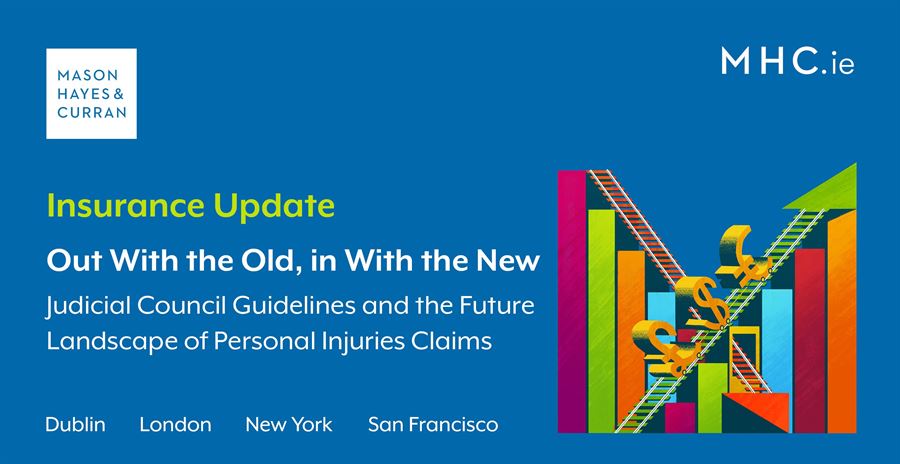
The judicial council guidelines represent a long-awaited review of the Book of Quantum. The stated aim of the guidelines is to promote predictability and consistency in awards of damages in personal injuries claims. While they appear to maintain judicial discretion, the guidelines are much more specific than the Book of Quantum and clearly set out the manner in which they are to be applied by the courts.
When will the guidelines apply?
The enacting legislation – the Family Leave and Miscellaneous Provisions Bill 2021 – amends section 99 of the Judicial Council Act 2019 which in turn amends section 22 of the Civil Liability and Courts Act 2004. The amendment states that the guidelines will apply to damages in a personal injuries action which is commenced on or after the date on which section 99 comes into operation.
The Book of Quantum will continue to apply where an action was commenced:
-
Before the date on which section 99 of the Act of 2019 comes into operation, or
-
On or after the date on which that section comes into operation in relation to a relevant claim where:
-
an assessment was made by the Personal Injuries Assessment Board in relation to that claim before the date of such coming into operation, and
-
that assessment was not, or was deemed not to have been, accepted
The effect of this is that we will be dealing with a dual system for the foreseeable future.
How will the guidelines apply?
The application of the guidelines will be mandatory. Any departure from the recommended quantum parameters will need to be justified by the trial judge. The guidelines direct that the trial judge will require brief submissions from each party setting out their view on the damages bracket of the dominant injury sustained, any less significant injuries and any other relevant considerations. The trial judge will need to decide, based on those submissions, how the guidelines will impact the Court’s award.
Determining the level of damages
In a similar manner as the Book of Quantum, the guidelines have set out a “ranking” system to determine “levels” of injury – minor, moderate, serious and severe. Each level has various factors which will inform the category of injury and in turn the applicable award.
The guidelines have also set out a non-exhaustive list of considerations which will impact the level of awards, to include:
-
Age of the plaintiff
-
Interference with quality of life and education
-
Impact on work
-
Impact on interpersonal relationships
-
Whether medical assistance has been sought
-
Nature, extent and duration of treatment undertaken and/or medication prescribed
-
Likely success of treatment
-
Prognosis, to include any future vulnerability
-
The extent and/or nature of any associated physical injuries
Multiple injuries
The guidelines make it clear that when determining an award for multiple injuries, the trial judge must identify the most significant aspect of the injury in order to determine the relevant bracket for damages. The award can be increased to reflect the additional pain and suffering of other injuries. Any uplift of the award must be proportionate to other more severe injuries dealt with under the guidelines. The calculation of damages for multiple injuries was not addressed under the Book of Quantum.
Novel claims
While the range of injuries covered under the guidelines is extensive, it is inevitable that there will be claims for injuries which have not been dealt with under the new guidelines. The guidelines provide that in cases involving novel injuries, the court should be guided by reference to equally significant injuries which are dealt with in the guidelines. This is to ensure that there is a uniform and proportionate approach to awards going forward. The Judicial Council plans to review the guidelines within 3 years of their adoption. Any injuries which have not been dealt with under the guidelines are likely to be considered for inclusion at that stage.
A glance at the guidelines
One of the starkest changes noted under the guidelines relates to soft tissue and whiplash injuries, which have both been significantly reduced. The guidelines acknowledge that “allegations of [whiplash] are easily made and not easily disproved”. In claims involving whiplash injuries, the guidelines require the court to make findings of fact on the issues of:
-
Whether whiplash was sustained, and
-
If so, the nature and extent of the injury
By way of illustration, a minor whiplash/soft tissue neck injury under the Book of Quantum could attract up to €19,400, while the suggested award under the guidelines range from €500 to €12,000.
The newcomers
One of the most interesting aspects of the guidelines is the introduction of new categories which were not previously dealt with in the Book of Quantum. One such example is psychiatric injury. The guidelines reiterate the long-established principle that recovery will only be permitted for a recognisable psychiatric injury. We expect that the inclusion of psychiatric injuries in the guidelines will result in PIAB dealing with claims which would have automatically been released without assessment under the old system.
Pain disorders have also been dealt with by the guidelines. This includes chronic pain syndrome, chronic fatigue and fibromyalgia. While there has been no attempt in the guidelines to subdivide each of the clinical pain conditions, the guidelines have specifically quantified complex regional pain syndrome (CRPS) with awards of up to €95,000. The presence of an overlapping psychiatric injury is also acknowledged as common in cases of pain disorders.
Scarring has also been addressed in the guidelines. The guidelines have subdivided the categories of scarring into facial and non-facial scarring and have recognised various factors which would result in an increased award, such as:
-
Consequential psychological damage including depression
-
Impact on work
-
Nature and extent of residual scarring or disfigurement
-
Age of plaintiff
Our thoughts on the guidelines
-
We understand that the enacting Bill was signed by the President this week and anticipate very little delay with a commencement notice. Once the guidelines take effect, they are likely to result in a large number of Circuit Court cases falling into the District Court and a smaller number of High Court cases dropping into the Circuit Court both with attendant costs savings to defendants
-
Comparatively speaking whilst the award brackets for many areas have decreased, it is surprising that some more serious injuries have actually been increased under the guidelines
-
The courts, of course, retain some scope to exercise discretion in determining whether to exceed the bands proposed in the new guidelines and the first series of judgements under the guidelines will be greatly anticipated
-
We expect to see an increase in psychological sequelae pleaded by plaintiffs. It may become a tool utilised in order to bridge the gap between “old” and “new” money
-
It is inevitable that a two-tier system will be in operation for the foreseeable future with “old money” and “new money” cases running in parallel. However the new guidelines may have an ameliorating effect on “old money” cases with the gap between the ranges lessening in the intervening period
-
It remains to be seen whether the delays in PIAB during the pandemic will create additional issues. Claims not previously assessed due to pandemic delays may now fall under the new guidelines and, if significantly affected under the new ranges, the claims may be subject to a challenge
For more information on successfully defending personal injury claims, contact a member of our Insurance & Risk team.
The content of this article is provided for information purposes only and does not constitute legal or other advice.







